Food for the Soul: Artists and the Moneychangers
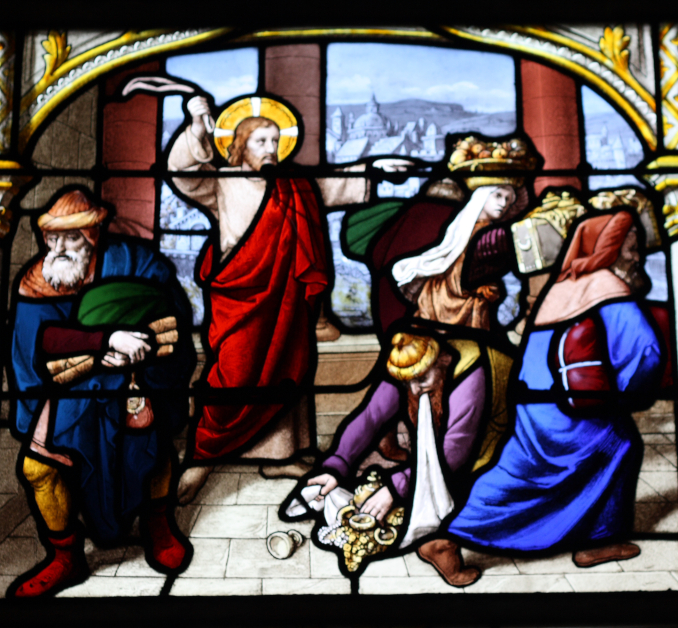
Christ Driving Moneylenders from the Temple. Church of St. Aignan (1899). Chartres, France. Photo: Reinhardhauke Wikimedia Commons
By Nina Heyn – Your Culture Scout
If you need to impart important messages to people who cannot read, then your choices include talking to them directly or showing them pictures—preferably images rendered in long-lasting materials such as stone, wood, or glass. This is the reason that Christian churches, especially the medieval ones, have such an abundance of scenes from the lives of Christ, his disciples, and saints. As early as the 7th century, Pope Gregory declared that church images should provide a “gospel for the unlettered.”
Toward the end of the Middle Ages, theologians began expanding beyond messages focused on Christ’s miraculous birth and martyrology to relate stories about events from his life, the aim being to provide congregations with examples of virtuous and pious conduct. One such example is the story that deals with Jesus’s outrage at the commercialization of a religious site, known as “Christ driving the money-changers from the temple.” This scene became and remained extremely popular in all the mediums and materials available to artists in different eras.
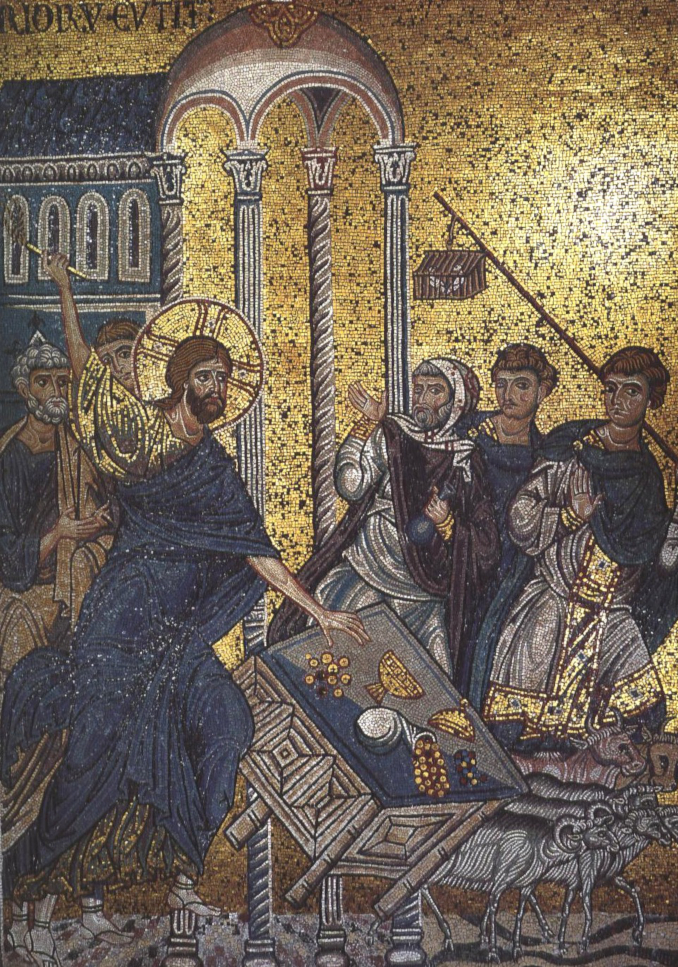
Jesus throws the sheep and cattle out of the temple and overturns the money-changers’ tables. (12th c.). Monreale Cathedral, Palermo, Italy. Photo: Wikimedia Commons
The 12th-century glass mosaic decorations from Monreale Cathedral in Palermo contain all the classic elements of this story—a wrathful Jesus in flowing robes raising leather thongs in the air, an overturned table with falling coins, and a group of cowed merchants who are fleeing from the advancing, larger-than-life figure of Jesus. The Monreale Cathedral is unusual in that it was built within one decade (whereas some major medieval structures took decades to rise), but the decorations inside took many years to be completed. Decorated by sophisticated Byzantine and Venetian glass artists, the walls radiate a green and gold sheen from countless images that are vivid and explicit, even bearing helpful captions in Latin. This particular story comes with the inscription, “Iesus ejecit de templo oves et boves et mensas nummularierum evertit” (“Jesus throws the sheep and cattle out of the temple and overturns the money-changers’ tables”). Although Monreale’s walls epitomize the Western art of mosaic, not long after these pictures were completed, the winds of stylistic change were destined to blow again—and both this medium of decorative art and its style soon gave way to painting.
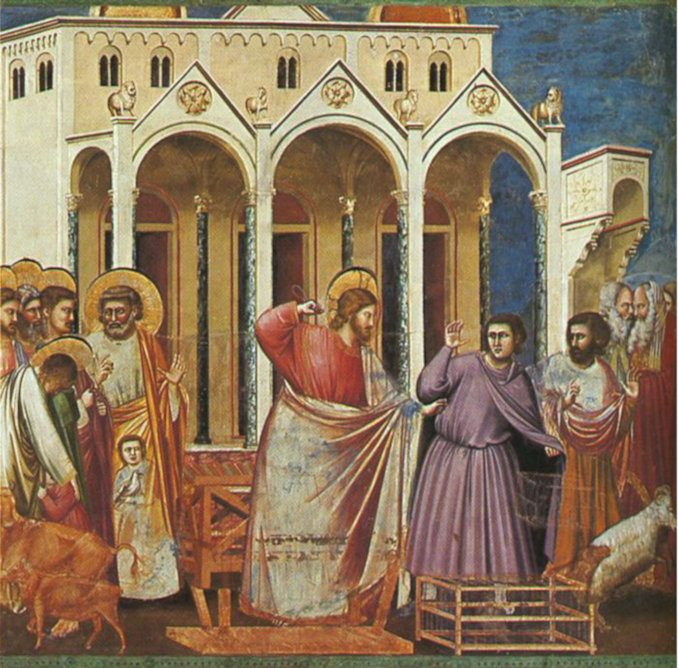
Expulsion of Merchants from the Temple. Giotto di Bondone (ca 1305). Scrovegni Chapel, Padua, Italy. Photo: Wikimedia Commons
The Scrovegni Chapel in Padua is similar to the Monreale Cathedral in that it aims to be a visual compendium of all Christian imagery. Unlike Palermo’s cathedral, however, the Padua chapel was decorated by one very distinct artist who is considered a primary precursor for Renaissance art if not for the entire style of Western painting: Giotto di Bondone.
The history of art owes this chapel to a guilty conscience. A banker named Enrico delli Scrovegni had the chapel built to atone for the sins of usury committed by his father Reginaldo, whose unrepentant behavior earned him the Church’s condemnation and a refusal of Christian burial. In 1303, Enrico commissioned Giotto to decorate the chapel’s interior with scenes from the life of Mary and Jesus, which the artist and his assistants created in dozens of glorious frescoes.
In Expulsion of Merchants from the Temple, all the traditional iconography is present—down to the whip of leather cords and the cattle tumbling out of the temple—but this is no longer classic Gothic art with its flat surfaces and symbolic poses. Instead, people are individualized in their expressions and gestures, all figures are tridimensional, and they are placed against the backdrop of realistically painted buildings. For centuries before, the most impressive religious decorations were rendered in Byzantine-style mosaics or French-style stained glass, while artists reserved paintings for the much smaller formats of miniatures or wood panels. Giotto ushered in the large-scale, naturalistic fresco, paving the way for subsequent Renaissance paintings that would feature solid, anatomically correct bodies, strong emotions, precise perspectives, and realistic elements of nature.
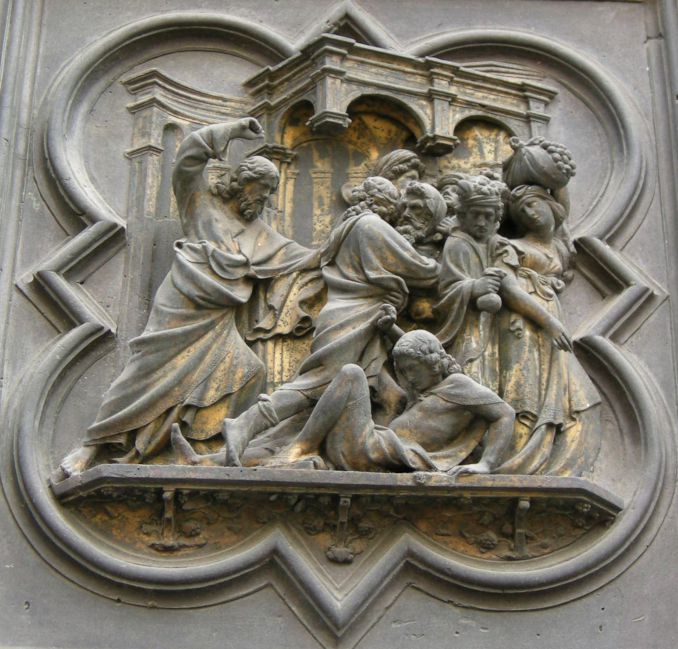
Casting the Merchants out from the Temple. Lorenzo Ghiberti (1403-1424). Bronze panel on the north door of the Baptistery of Saint John, Florence, Italy. Photo: Sailko Wikimedia Commons
What better location for religious illustrations than the door of a building that would be visited or at least seen by passers-by all year long? The world-famous Baptistery of San Giovanni in Florence — one of the oldest structures in the city center — is such a building. It was built on the site of a Roman temple, which was initially followed by a 6th-century church and later consecrated (in the 11th century) as a new baptistery. Its characteristic green and white marble pattern was copied in countless other Renaissance buildings afterwards.
Two of the three entrance doors were created by Lorenzo Ghiberti, a Florentine artist who won a competition against Filippo Brunelleschi. The latter was so soured by his defeat that he departed for Rome to study architecture (and, as a result, Florence got its famous Dome in 1436—one of the most daring pieces of architecture in Europe). Ghiberti was barely 21 when he won the commission for the first doors. It took him over 20 years to complete the north door and then another 27 years to complete an even grander eastern entrance, so sumptuous that Michelangelo hailed the pair of doors as the “Gates of Paradise,” which is how people have referred to them ever since.
Ghiberti created the doors that are now on the north side as a series of quatrefoil panels, one of which depicts Jesus’s wrath at the money-changers. This panel is more or less at eye level and thus easy for people to contemplate while waiting to get in—something that I experienced as a tourist some 600 years after the door was first installed. Ghiberti was quite aware that he had created not only something artistically outstanding but also a new style of perspective in reliefs. He was very proud of his achievements and wrote in his autobiography, “In this work I sought to imitate nature as closely as possible, both in proportions and in perspective as well as in the beauty and picturesqueness of the composition and the numbers of figures. . . .”

Christ Driving the Traders from the Temple. El Greco (c. 1600). The National Gallery, London, United Kingdom. Photo: Wikimedia Commons
El Greco painted five versions of the money-changers scene over the span of 40 years. His first two were painted in 1568 and 1571, when the young Cretan artist was living in Rome and hoping for papal commissions. Modesty and diplomacy were not his strong suit; he not only managed to antagonize his patrons but also derided Michelangelo, declaring that “he was a good man but he did not know how to paint” . . . and then offering to repaint the Sistine Chapel. El Greco’s art criticism did not stop him from borrowing heavily from various Italian masters in the first two versions of Christ Cleansing the Temple. These “Roman-period” paintings are full of Renaissance-style poses, and the Temple building looks like a classic Italian palazzo interior. El Greco’s characteristic style of elongated figures had not yet developed.
Forty years later, when El Greco was living in Toledo and in full command of his unique style, the same theme got a different treatment. Gone are the Italianate interiors, while his figures are stretched in his inimitable style and twisted in a Mannerist ideal of the figura serpentinata. In all five versions, the artist kept a frontal position of the walking Christ—much different from the traditional side view—allowing us, the viewers, to be a “part of the action.” We are there in the Temple, watching Jesus stride through a tight group of people leaning away from the whip’s lashes or clustering to the sides, heads shaking in astonishment. It’s an emotional scene of religious fervor, very much in tune with the spirit of counter-Reformation in Spain and the artist’s own religiosity.
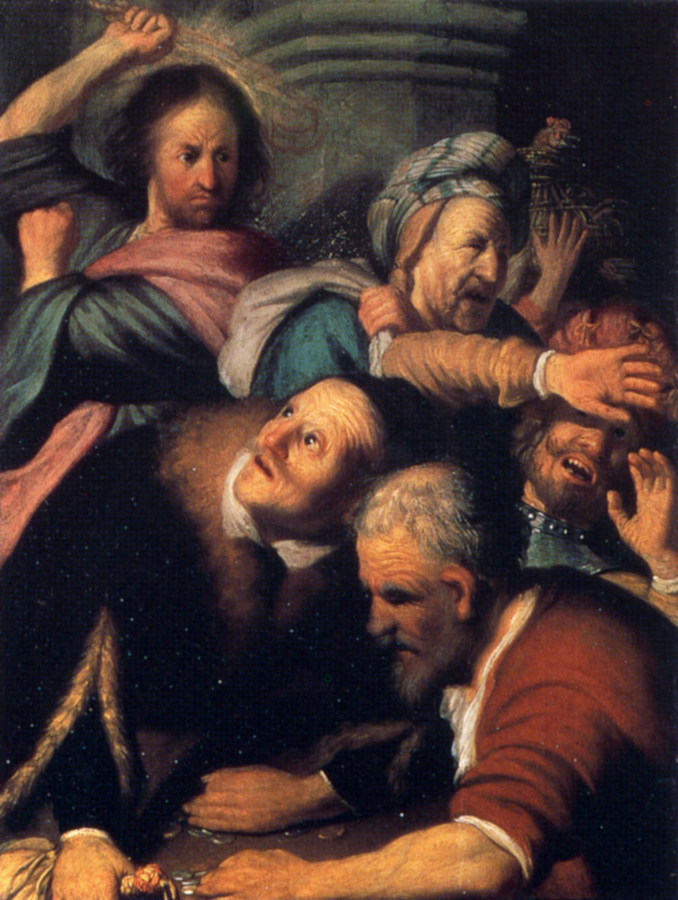
Christ Driving the Moneychangers from the Temple. Rembrandt (1626). Pushkin State Museum, Moscow, Russia. Photo: Wikimedia Commons
In the 350 years since Rembrandt’s passing, the world has become quite familiar with his self-portraits and large-scale canvases like The Night Watch. Rembrandt’s religious art, though once popularized heavily through etchings that were printed all over Christendom, is perhaps less familiar these days, but it is through these early religious paintings that the artist developed his style and entered the busy decorative market of the Dutch Republic. When he painted Christ Driving the Moneychangers from the Temple in 1626, he was barely one year out of apprenticeship; this was well before he acquired important patronages and five years before he moved to the city where he achieved success: Amsterdam. In 1626, the 20-year old Rembrandt was still living in Leyden, sharing rooms with another painter and trying to make a name for himself. Historic and religious scenes were considered the most prestigious (with much less value attached to genre scenes and landscapes) and the brash young artist went for the high-prestige scenes right away.
Christ Driving the Moneychangers from the Temple is, as we would say today, a “close-up.” Rembrandt is using the well-known story to concentrate on the different expressions of Christ and four clustered figures. There is righteous anger, quiet avarice, expressive pain, and wide-eyed astonishment. There are also broad gestures, varied costumes, and distinctive facial features. The colors are a bit harsh and the brushwork is not yet precise, but there is so much drama in this moment of great emotions. A few years later, the artist created a more conventional image of this story in an etching, but this early oil has all the energy of a 20-year-old’s creative spirit.
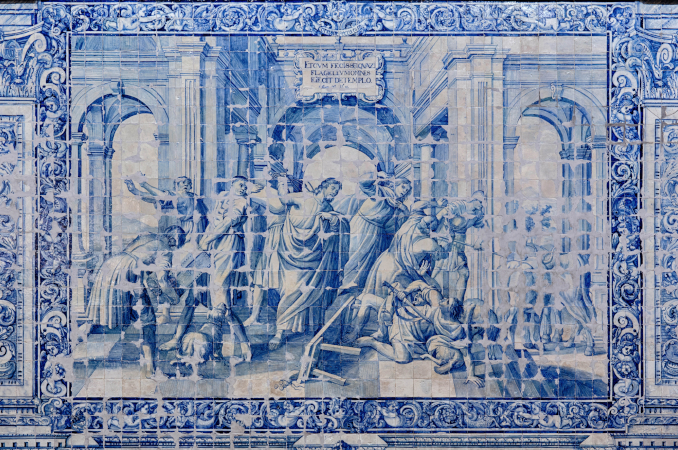
The Cleansing of the Temple. António de Oliveira Bernardes (early 18th century). Church of Mercy, Évora, Portugal. Photo: Wikimedia Commons
Tilework designs and paintings called azulejos have been a decorative tradition in Portugal and Spain since the 13th century. Originally based on Arabic designs, attesting to the long Moorish presence on the Iberian peninsula, they later evolved thanks to Dutch paintings and porcelain, Italian majolica earthenware, and other tilework influences. By the 18th century, when António de Oliveira Bernardes made this azulejo, there was a fashion for white and blue tiles made by artists from Delft as well as local designers. De Oliveira Bernardes was such an artist, and he created tiles for The Cleansing of the Temple in a small church in the Portuguese city of Évora. It is one of the oldest cities in Europe, with its old town declared a UNESCO heritage site. The walls of the Church of Mercy are lined with scenes that illustrate seven spiritual works of mercy (“admonishing the sinners” being one of them)—all expressed in intricate tile paintings in bright cobalt blue.
Looking at these exquisite works of art, I’m struck by the irony of how they came to life. Although the images admonish against mixing the spiritual with the commercial, all these artworks were paid for by donors and sponsors. For example, it was Reginaldo Scrovegni’s unscrupulous amassing of wealth that ultimately enabled his son to hire Giotto for decades to create the Padua frescoes. Ultimately, even art conveying profound spiritual messages needs patrons…and sometimes these patrons include money-changers (or bankers, as we would say today) as well.
